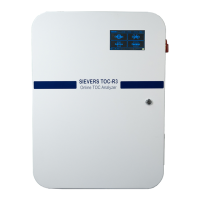TROUBLESHOOTING
Chapter 7
............
Sievers TOC-R3 Operation and Maintenance Manual
DLM 95000-01 EN Rev. A 219 © Veolia 2023
Inspecting Externally
• Confirm that the display is illuminated while powered On.
• Confirm that there are sufficient volumes of Acid, Dilution/Rinse Water (if used),
and Check Standard (if used) in the carboys.
• Confirm that there are no leaks present at the sample inlet(s) or waste outlet
connections.
• Confirm that there are no liquid leaks underneath the Analyzer and any optional
hardware Accessories.
• Ensure that there is no paper or other material blocking the cooling air inlet on the
right side of the Analyzer and outlet on the left side of the Analyzer (which vents
hot air out).
• If you are experiencing erratic carbon readings, confirm that the pH of the waste
stream is not too high. The pH should equal 2 or less.
• Confirm that all cables are securely attached to the Analyzer.
• Perform a visual inspection of the Air Scrubber, if using. If using Soda Lime with
indicator, check the color of the Soda Lime granules. The granules changes from
white to a blue color (if using Soda Lime with indicator) when spent.
• If the Analyzer is making measurements:
► Sample, Acid, Check Standard (if using), and Dilution Water (if using)
should be drawn into the Analyzer periodically, unless the selected
analytical Method does not use Acid.
► Liquid waste should flow periodically from the Waste Outlet. Insert the
loose end of the Waste Outlet tube into a flask of water to confirm that
liquid is flowing. Ensure the waste is properly disposed of after confirming
it is working correctly.
► Confirm that the cooling air blows out Furnace Exhaust on the left side of
the Analyzer.
Inspecting Internally
Open the Analyzer door and do the following:
• Check for leaks throughout the Analyzer; there should not be moisture on the
inside floor of the Analyzer case.
• Confirm that the Acid, Dilution/Rinse Water (if using), and Check Standard (if
using) tubes inside the Analyzer are full of liquid, or contain only a few bubbles. If
excessive bubbles are present, a Reactor Rinse should be performed. Look to
see if air flows into the lines during rinsing.
• Confirm that the Sample Pump (GP1) is running.
• Confirm that the Acid Pump (GP3) is pumping.
• Confirm that the Dilution Pump (GP4) is running, if using.

